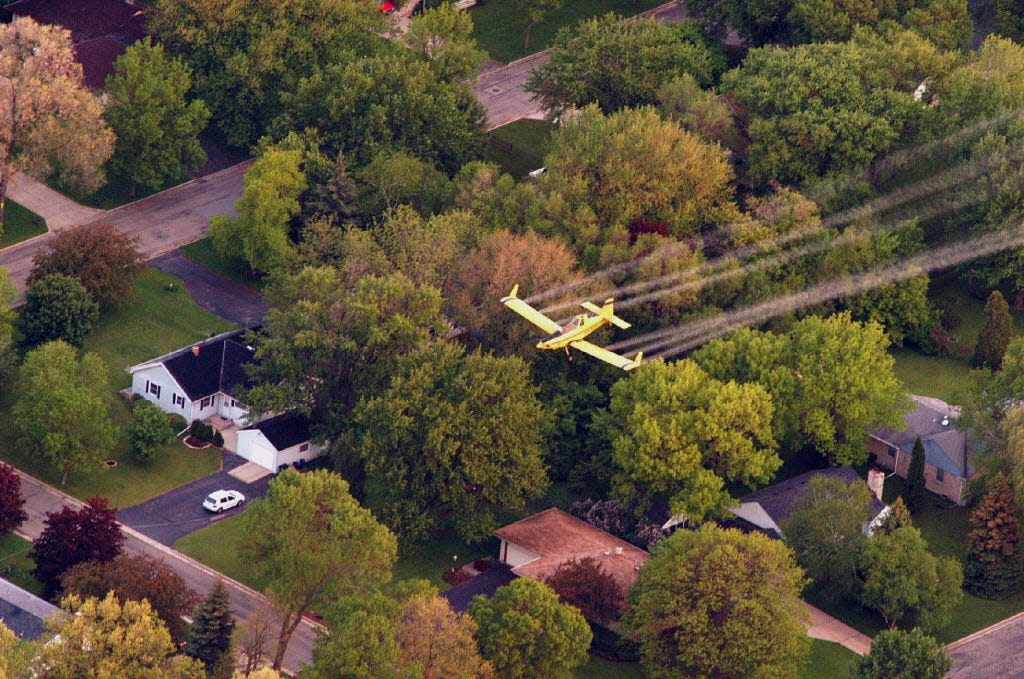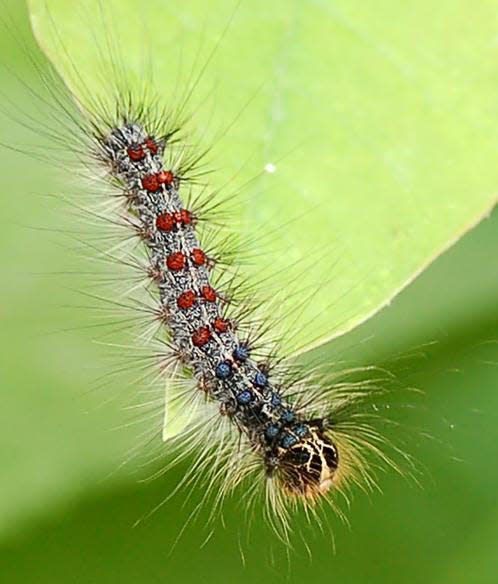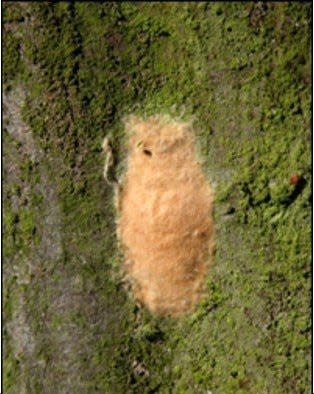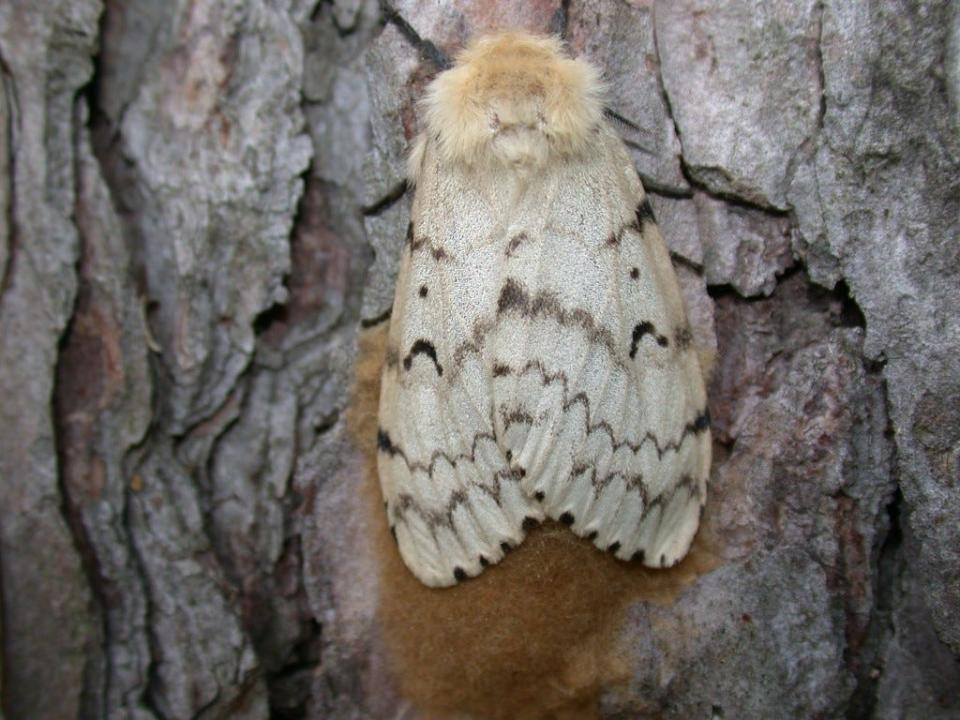DNR to use planes to spray for spongy moth over Kettle Moraine State Forest, Devil's Lake

If you see a low-flying plane spraying something over the Kettle Moraine State Forest's Southern Unit or Devil's Lake State Park sometime in the next month, don't be alarmed.
The Wisconsin Department of Natural Resources will be conducting aerial spraying operations through early June to combat spongy moth, an invasive species that in its caterpillar stage defoliates trees and can devastate forests during an outbreak, which occurs every five to 10 years.
The moth, which was previously known as the gypsy moth, is one reason Wisconsin has rules against transporting firewood.
In February, the Entomological Society of America adopted spongy moth as the insect's new common name. It's derived from the common name used in France and French-speaking Canada, "spongieuse," which refers to the moth's sponge-like egg masses, according to the ESA.
“(Gypsy) is an ethnic slur to begin with that’s been rejected by the Romani people a long time ago,” ESA President Michelle S. Smith told the AP last July. “Second, nobody wants to be associated with a harmful invasive pest.”
Aerial spraying is one way to combat the pest, and the DNR has conducted operations before. Planes fly 50 to 100 feet above the trees to deploy the spray, an insecticide called Foray that contains a naturally occurring soil bacteria, Bacillus thuringiensis var. kurstaki (Btk). The bacteria kills spongy moth caterpillars when they ingest it.

The insecticide, which is approved by the Organic Materials Review Institute for use in organic food farming, is not toxic to people, pets or bees and degrades naturally within 10 days. The DNR is advising people with severe allergies that they might want to stay indoors during nearby applications, however, and noting that the planes might be loud, since they have to fly close to the treetops where the larvae feed.
More: 10 of the best Wisconsin state parks to visit this summer
Andrea Diss-Torrance, invasive forest insects program coordinator for the DNR, said she's been on the ground for many of these spraying operations and described the insecticide like "dirty water" or "a fine mist of stale beer" — something any Wisconsinite who's been to a Brewers or Packers game is probably familiar with.
So while you don't want to get it in your eyes or mouth, it's not harmful if it gets on you, and you can easily wash it off yourself and your belongings, including cars.
Diss-Torrance said they try to spray first thing in the morning on weekdays, when people are less likely to be out and about, but operations can stretch into the afternoon, depending on the weather.
When exactly they will spray depends on the weather as well. They aim to catch the caterpillar 10 to 14 days following peak hatch, which usually occurs when there is dry, hot weather like this week. That means they might be spraying the week of May 23, and definitely before Memorial Day weekend.
Diss-Torrance said they'll be targeting two high-use areas in the parks where there are already fewer trees, so losing any more there would be a big deal.
"We have to keep those trees in place, because we cannot replace them," she said. "These trees are super important and are the whole reason for these parks. We have to have places where people can enjoy big, beautiful trees. ... We have put (the trees) in risky situations. They're not in woodlands anymore. We compact the soil on their roots, we change the pH. ... If we put them in harm's way, we must protect them when they're threatened, and this is a threat that's easily managed, so we must do so."
In the Kettle Moraine State Forest, they'll be treating the John Muir Biking & Hiking and Nordic Skiing & Hiking trailheads on County Highway H east of Whitewater. In Devil's Lake, they'll spray over the north and south shore day use areas as well as the north side campgrounds, Quartzite and Northern Lights.

In both parks, signs and staff will warn visitors of the spraying operations, and visitors can call the Spongy Moth Information Line (800-642-6684, option 1) to hear where spraying is scheduled to occur the following day.
The treatments are narrowly targeted to areas where they are really needed, not only because they are expensive, but also because they do cause minor ecological disruption.
But Diss-Torrance said the areas they spray are already heavily disrupted by visitors anyway. And because the areas around there are not treated, other species that are affected, like tent caterpillars, usually bounce back in the treatment area within a couple of years.
"We're not really worried about disrupting the ecosystem of the picnic area of the north shore (in Devil's Lake)," she said. "It's much more affected by what people are doing below."
Spongy moth outbreaks
The spongy moth, however, takes longer to bounce back, with temporary large population increases, or "outbreaks," occurring every five to 10 years.

In normal years, only two out of 600 or 700 eggs in an egg mass will survive — essentially replacing the existing population. But if conditions are favorable for survival, including dry, hot weather, that might jump to four or six per egg mass, and "that's when the population takes off," Diss-Torrance said.
The caterpillars, which measure about 2 inches long and have hairy spikes and a pattern of dark red and blue spots, feed on 300 species of trees, but they're particularly fond of oaks and aspens.
Trees can handle about 50% defoliation, Diss-Torrance said, but when they lose more leaves than that, they tap into their root reserves to make more. Those root reserves would have been used to make leaves the following year, thus weakening the trees and putting them on a precarious path.
The DNR uses spray and insecticides only for extreme situations; they're part of an overall strategy for managing the pest that includes biological measures like a fungus called Entomophaga maimaiga.
The fungus native to Japan has successfully controlled the population there as well as in New England and Wisconsin during outbreaks in 2004 and 2010.
"This is the smallpox equivalence for spongy moth," Diss-Torrance said, noting the fungus almost exclusively targets spongy moths. "We mapped zero defoliation (in 2004). It was super effective. ... We were really happy about that, and then it happened again in 2010."
The effectiveness of the fungus depends on the weather, too, as it needs cooler, wetter weather to thrive.
Even with an effective biological control, however, the DNR takes extra precautions — aerial spraying — in high-use areas.
"You can lose a tree here or there (in the forest), but in a picnic area, you lose a single tree, it's a big deal," Diss-Torrance said. "That's why we take these more protective stances."

More information: The DNR is working on changing all references in its materials to spongy moth, but for now the department's spongy moth portal is gypsymoth.wi.gov.
The portal contains information on DNR efforts to combat spongy moth, mitigation methods for your own property, a sign-up for email alerts on spraying operations and the Spongy Moth Information Line (800-642-6684, option 1).
Contact Chelsey Lewis at clewis@journalsentinel.com. Follow her on Twitter at @chelseylew and @TravelMJS and Facebook at Journal Sentinel Travel.
Our subscribers make this reporting possible. Please consider supporting local journalism by subscribing to the Journal Sentinel at jsonline.com/deal.
DOWNLOAD THE APP: Get the latest news, sports and more
This article originally appeared on Milwaukee Journal Sentinel: DNR planes to spray for spongy moth at Devil's Lake, Kettle Moraine

